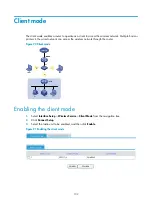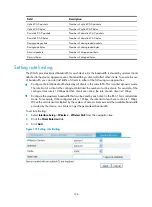
115
Configuring WLAN security
When it comes to security, a WLAN is inherently weaker than a wired LAN because all the wireless
devices use the air as the transmission media, which means that the data transmitted by one device can
be received by any other device within the coverage of the WLAN. To improve WLAN security, you can
use white and black lists and user isolation to control user access and behavior.
Blacklist and white list
You can configure the blacklist and white list functions to filter frames from WLAN clients and thereby
implement client access control.
The WLAN client access control is accomplished through the following three types of lists.
•
White list
—Contains the MAC addresses of all clients allowed to access the WLAN. If the whitelist
is used, only permitted clients can access the WLAN, and all frames from other clients will be
discarded.
•
Static blacklist
—Contains the MAC addresses of clients forbidden to access the WLAN. This list is
manually configured.
•
Dynamic blacklist
—Contains MAC addresses of clients whose frames will be dropped. A client is
dynamically added to the list if it is considered sending attacking frames until the timer of the entry
expires.
When a device receives an 802.11 frame, it checks the source MAC address of the frame and processes
the frame as follows:
1.
If the source MAC address does not match any entry in the white list, it is dropped. If there is a
match, the frame is considered valid and will be further processed.
2.
If no white list entries exist, the static and dynamic blacklists are searched.
If the source MAC address matches an entry in any of the two lists, it is dropped.
If there is no match, or no blacklist entries exist, the frame is considered valid and will be further
processed.
Configuring the blacklist and white list functions
Configuring dynamic blacklist
Select
Interface Setup
>
Wireless
>
Security
from the navigation tree, and then click the
Blacklist
tab.
Summary of Contents for MSR SERIES
Page 17: ...xv Documents 835 Websites 835 Conventions 836 Index 838 ...
Page 20: ...3 Figure 3 Initial page of the Web interface ...
Page 42: ...25 Figure 13 Firefox Web browser setting ...
Page 59: ...42 Figure 27 Checking the basic service configuration ...
Page 73: ...56 Figure 35 Sample interface statistics ...
Page 156: ...139 Figure 139 Rebooting the 3G modem ...
Page 168: ...151 Figure 152 Configuring Web server 2 ...
Page 174: ...157 Figure 158 Configure the URL filtering function ...
Page 242: ...225 Figure 233 Enabling the DHCP client on interface Ethernet 0 1 ...
Page 247: ...230 Figure 236 The page for configuring an advanced IPv4 ACL ...
Page 255: ...238 Figure 241 Advanced limit setting ...
Page 298: ...281 e Click Apply 2 Configure Router B in the same way Router A is configured ...
Page 400: ...383 Figure 387 Verifying the configuration ...
Page 405: ...388 ...
Page 523: ...506 Figure 530 Ping configuration page ...
Page 775: ...758 Figure 785 Configuring a jump node ...
















































